SOCIOLOGY 2: Essay on the Romanticism Art Movement and Its Impact
VerifiedAdded on 2022/09/09
|7
|1285
|19
Essay
AI Summary
This essay delves into the Romanticism art movement, exploring its origins, characteristics, and significance within art history. It focuses on two prominent artists, Theodore Gericault and Eugene Delacroix, examining their key works, "The Raft of the Medusa" and "Death of Sardanapalus," respectively. The essay analyzes the artists' contributions to the movement, the impact of their works, and the influence of Romanticism on subsequent artistic developments. Through detailed analysis and references, the essay provides a comprehensive overview of this influential period in art history, highlighting its emphasis on emotion, individualism, and the sublime.
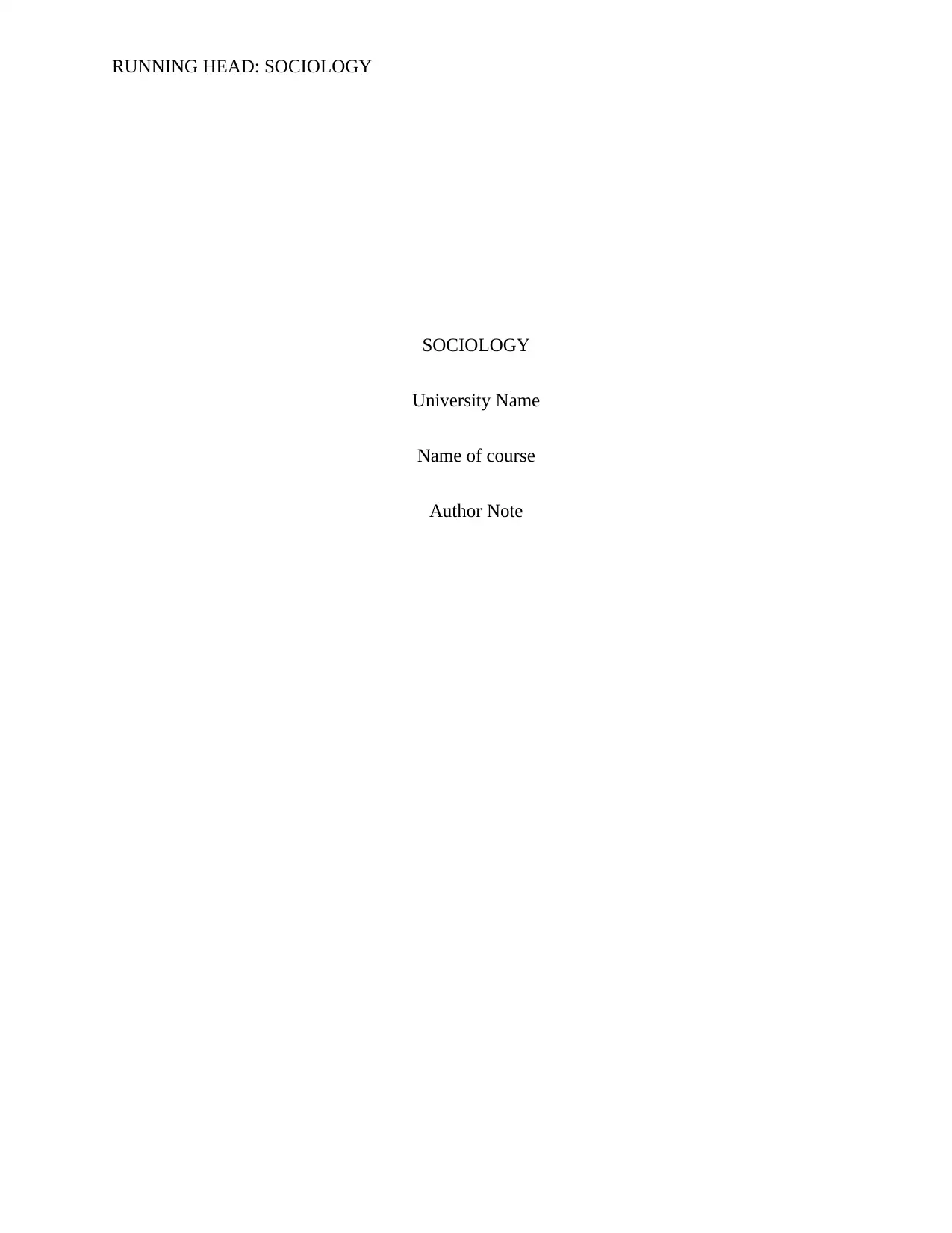
RUNNING HEAD: SOCIOLOGY
SOCIOLOGY
University Name
Name of course
Author Note
SOCIOLOGY
University Name
Name of course
Author Note
Paraphrase This Document
Need a fresh take? Get an instant paraphrase of this document with our AI Paraphraser
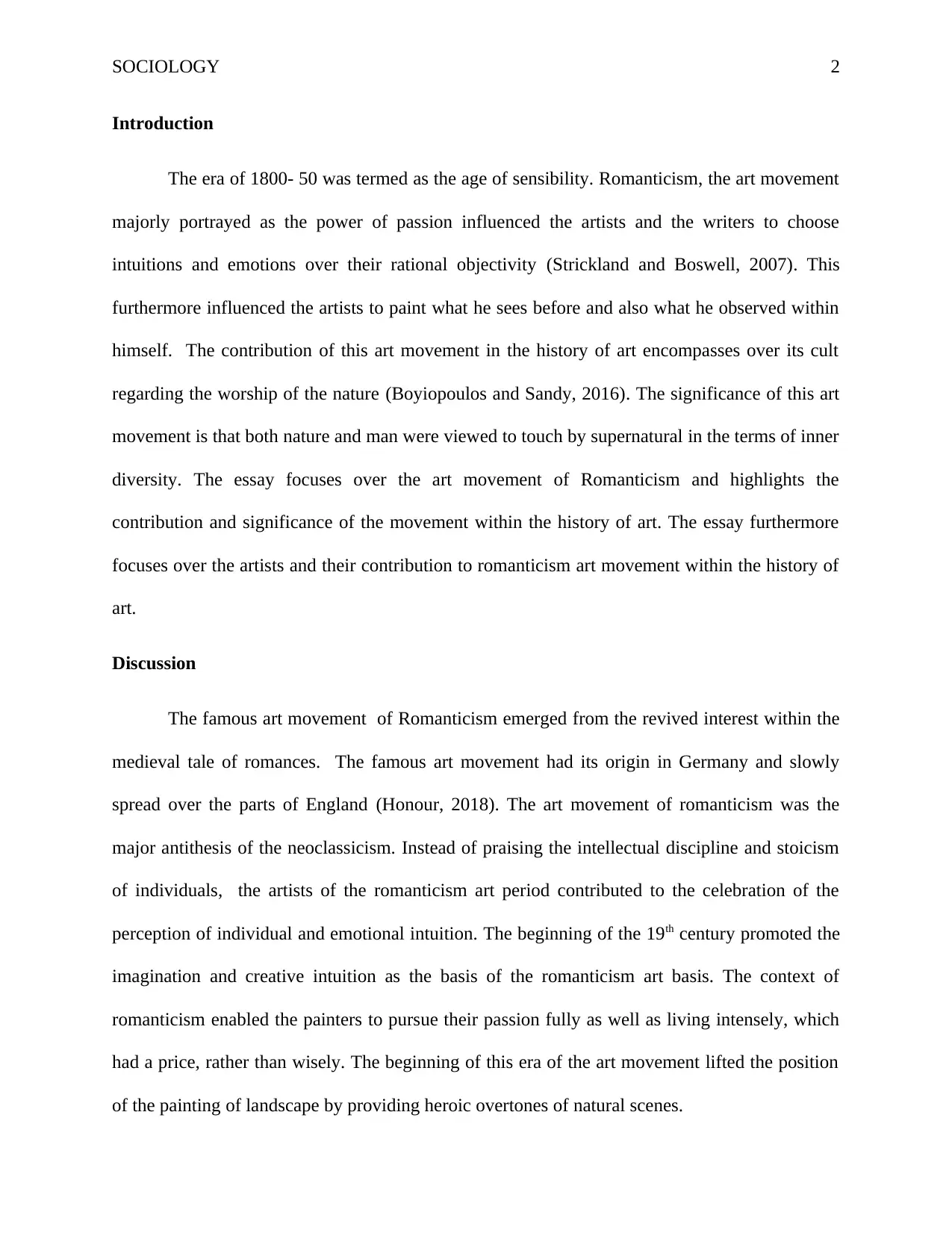
SOCIOLOGY 2
Introduction
The era of 1800- 50 was termed as the age of sensibility. Romanticism, the art movement
majorly portrayed as the power of passion influenced the artists and the writers to choose
intuitions and emotions over their rational objectivity (Strickland and Boswell, 2007). This
furthermore influenced the artists to paint what he sees before and also what he observed within
himself. The contribution of this art movement in the history of art encompasses over its cult
regarding the worship of the nature (Boyiopoulos and Sandy, 2016). The significance of this art
movement is that both nature and man were viewed to touch by supernatural in the terms of inner
diversity. The essay focuses over the art movement of Romanticism and highlights the
contribution and significance of the movement within the history of art. The essay furthermore
focuses over the artists and their contribution to romanticism art movement within the history of
art.
Discussion
The famous art movement of Romanticism emerged from the revived interest within the
medieval tale of romances. The famous art movement had its origin in Germany and slowly
spread over the parts of England (Honour, 2018). The art movement of romanticism was the
major antithesis of the neoclassicism. Instead of praising the intellectual discipline and stoicism
of individuals, the artists of the romanticism art period contributed to the celebration of the
perception of individual and emotional intuition. The beginning of the 19th century promoted the
imagination and creative intuition as the basis of the romanticism art basis. The context of
romanticism enabled the painters to pursue their passion fully as well as living intensely, which
had a price, rather than wisely. The beginning of this era of the art movement lifted the position
of the painting of landscape by providing heroic overtones of natural scenes.
Introduction
The era of 1800- 50 was termed as the age of sensibility. Romanticism, the art movement
majorly portrayed as the power of passion influenced the artists and the writers to choose
intuitions and emotions over their rational objectivity (Strickland and Boswell, 2007). This
furthermore influenced the artists to paint what he sees before and also what he observed within
himself. The contribution of this art movement in the history of art encompasses over its cult
regarding the worship of the nature (Boyiopoulos and Sandy, 2016). The significance of this art
movement is that both nature and man were viewed to touch by supernatural in the terms of inner
diversity. The essay focuses over the art movement of Romanticism and highlights the
contribution and significance of the movement within the history of art. The essay furthermore
focuses over the artists and their contribution to romanticism art movement within the history of
art.
Discussion
The famous art movement of Romanticism emerged from the revived interest within the
medieval tale of romances. The famous art movement had its origin in Germany and slowly
spread over the parts of England (Honour, 2018). The art movement of romanticism was the
major antithesis of the neoclassicism. Instead of praising the intellectual discipline and stoicism
of individuals, the artists of the romanticism art period contributed to the celebration of the
perception of individual and emotional intuition. The beginning of the 19th century promoted the
imagination and creative intuition as the basis of the romanticism art basis. The context of
romanticism enabled the painters to pursue their passion fully as well as living intensely, which
had a price, rather than wisely. The beginning of this era of the art movement lifted the position
of the painting of landscape by providing heroic overtones of natural scenes.
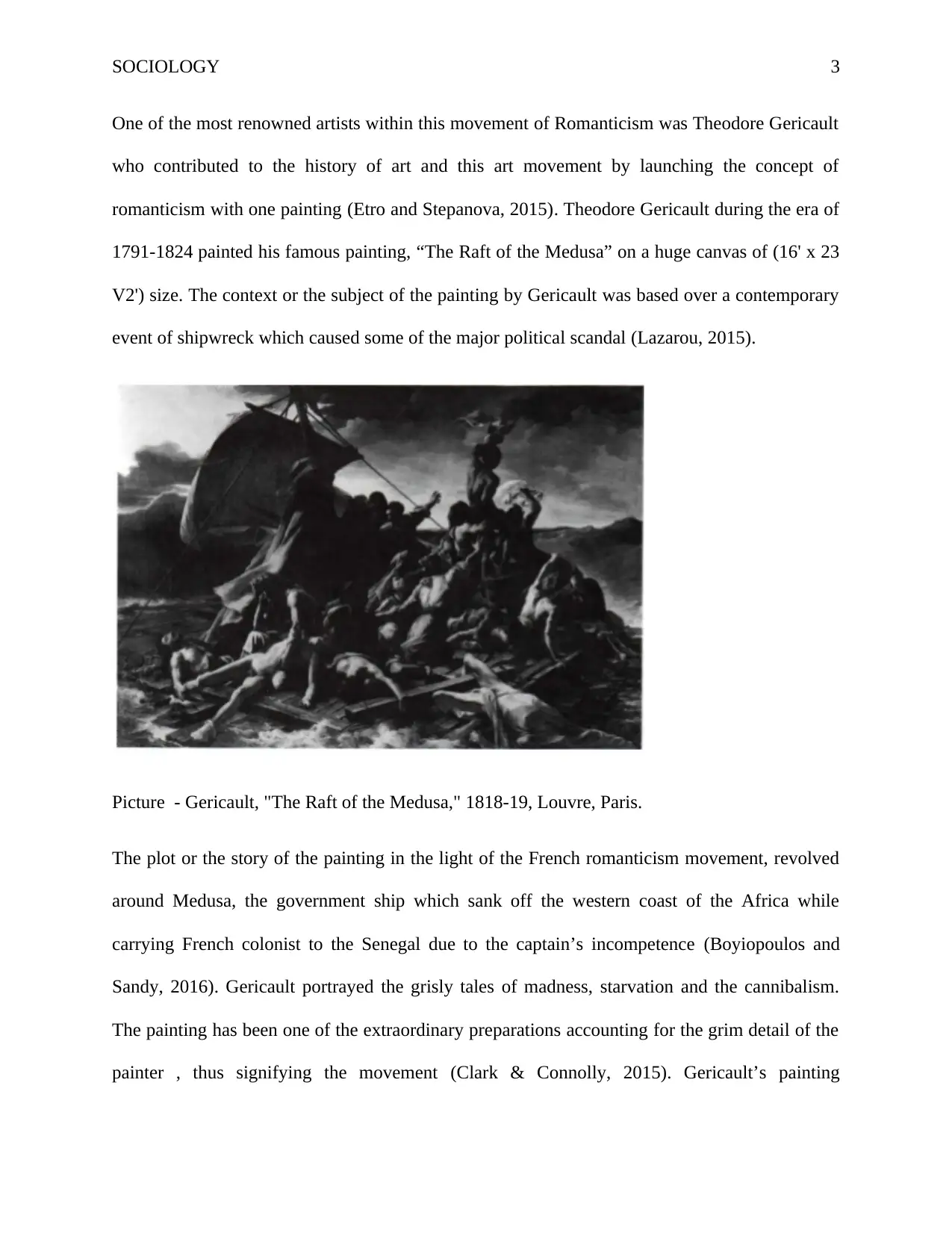
SOCIOLOGY 3
One of the most renowned artists within this movement of Romanticism was Theodore Gericault
who contributed to the history of art and this art movement by launching the concept of
romanticism with one painting (Etro and Stepanova, 2015). Theodore Gericault during the era of
1791-1824 painted his famous painting, “The Raft of the Medusa” on a huge canvas of (16' x 23
V2') size. The context or the subject of the painting by Gericault was based over a contemporary
event of shipwreck which caused some of the major political scandal (Lazarou, 2015).
Picture - Gericault, "The Raft of the Medusa," 1818-19, Louvre, Paris.
The plot or the story of the painting in the light of the French romanticism movement, revolved
around Medusa, the government ship which sank off the western coast of the Africa while
carrying French colonist to the Senegal due to the captain’s incompetence (Boyiopoulos and
Sandy, 2016). Gericault portrayed the grisly tales of madness, starvation and the cannibalism.
The painting has been one of the extraordinary preparations accounting for the grim detail of the
painter , thus signifying the movement (Clark & Connolly, 2015). Gericault’s painting
One of the most renowned artists within this movement of Romanticism was Theodore Gericault
who contributed to the history of art and this art movement by launching the concept of
romanticism with one painting (Etro and Stepanova, 2015). Theodore Gericault during the era of
1791-1824 painted his famous painting, “The Raft of the Medusa” on a huge canvas of (16' x 23
V2') size. The context or the subject of the painting by Gericault was based over a contemporary
event of shipwreck which caused some of the major political scandal (Lazarou, 2015).
Picture - Gericault, "The Raft of the Medusa," 1818-19, Louvre, Paris.
The plot or the story of the painting in the light of the French romanticism movement, revolved
around Medusa, the government ship which sank off the western coast of the Africa while
carrying French colonist to the Senegal due to the captain’s incompetence (Boyiopoulos and
Sandy, 2016). Gericault portrayed the grisly tales of madness, starvation and the cannibalism.
The painting has been one of the extraordinary preparations accounting for the grim detail of the
painter , thus signifying the movement (Clark & Connolly, 2015). Gericault’s painting
⊘ This is a preview!⊘
Do you want full access?
Subscribe today to unlock all pages.

Trusted by 1+ million students worldwide
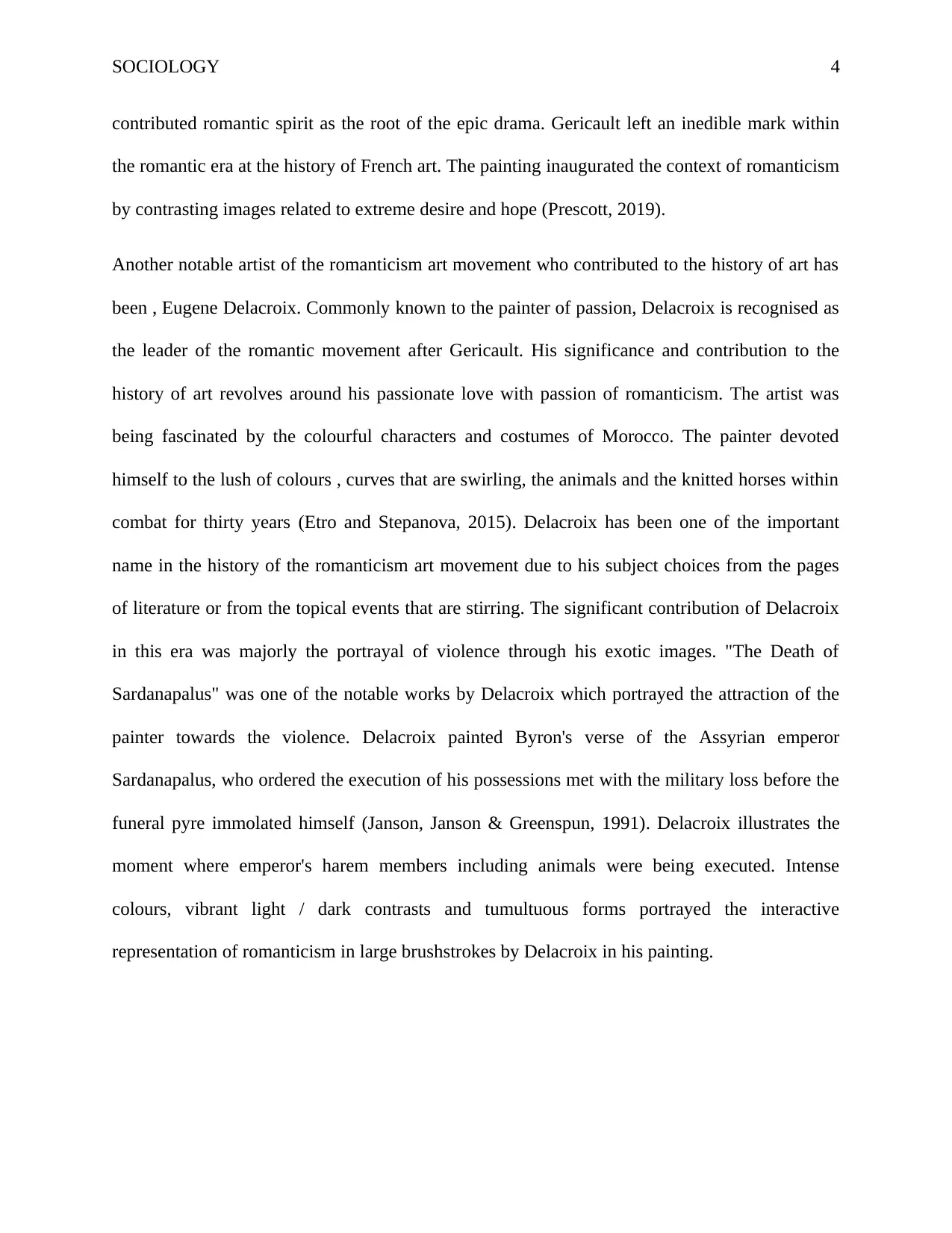
SOCIOLOGY 4
contributed romantic spirit as the root of the epic drama. Gericault left an inedible mark within
the romantic era at the history of French art. The painting inaugurated the context of romanticism
by contrasting images related to extreme desire and hope (Prescott, 2019).
Another notable artist of the romanticism art movement who contributed to the history of art has
been , Eugene Delacroix. Commonly known to the painter of passion, Delacroix is recognised as
the leader of the romantic movement after Gericault. His significance and contribution to the
history of art revolves around his passionate love with passion of romanticism. The artist was
being fascinated by the colourful characters and costumes of Morocco. The painter devoted
himself to the lush of colours , curves that are swirling, the animals and the knitted horses within
combat for thirty years (Etro and Stepanova, 2015). Delacroix has been one of the important
name in the history of the romanticism art movement due to his subject choices from the pages
of literature or from the topical events that are stirring. The significant contribution of Delacroix
in this era was majorly the portrayal of violence through his exotic images. "The Death of
Sardanapalus" was one of the notable works by Delacroix which portrayed the attraction of the
painter towards the violence. Delacroix painted Byron's verse of the Assyrian emperor
Sardanapalus, who ordered the execution of his possessions met with the military loss before the
funeral pyre immolated himself (Janson, Janson & Greenspun, 1991). Delacroix illustrates the
moment where emperor's harem members including animals were being executed. Intense
colours, vibrant light / dark contrasts and tumultuous forms portrayed the interactive
representation of romanticism in large brushstrokes by Delacroix in his painting.
contributed romantic spirit as the root of the epic drama. Gericault left an inedible mark within
the romantic era at the history of French art. The painting inaugurated the context of romanticism
by contrasting images related to extreme desire and hope (Prescott, 2019).
Another notable artist of the romanticism art movement who contributed to the history of art has
been , Eugene Delacroix. Commonly known to the painter of passion, Delacroix is recognised as
the leader of the romantic movement after Gericault. His significance and contribution to the
history of art revolves around his passionate love with passion of romanticism. The artist was
being fascinated by the colourful characters and costumes of Morocco. The painter devoted
himself to the lush of colours , curves that are swirling, the animals and the knitted horses within
combat for thirty years (Etro and Stepanova, 2015). Delacroix has been one of the important
name in the history of the romanticism art movement due to his subject choices from the pages
of literature or from the topical events that are stirring. The significant contribution of Delacroix
in this era was majorly the portrayal of violence through his exotic images. "The Death of
Sardanapalus" was one of the notable works by Delacroix which portrayed the attraction of the
painter towards the violence. Delacroix painted Byron's verse of the Assyrian emperor
Sardanapalus, who ordered the execution of his possessions met with the military loss before the
funeral pyre immolated himself (Janson, Janson & Greenspun, 1991). Delacroix illustrates the
moment where emperor's harem members including animals were being executed. Intense
colours, vibrant light / dark contrasts and tumultuous forms portrayed the interactive
representation of romanticism in large brushstrokes by Delacroix in his painting.
Paraphrase This Document
Need a fresh take? Get an instant paraphrase of this document with our AI Paraphraser
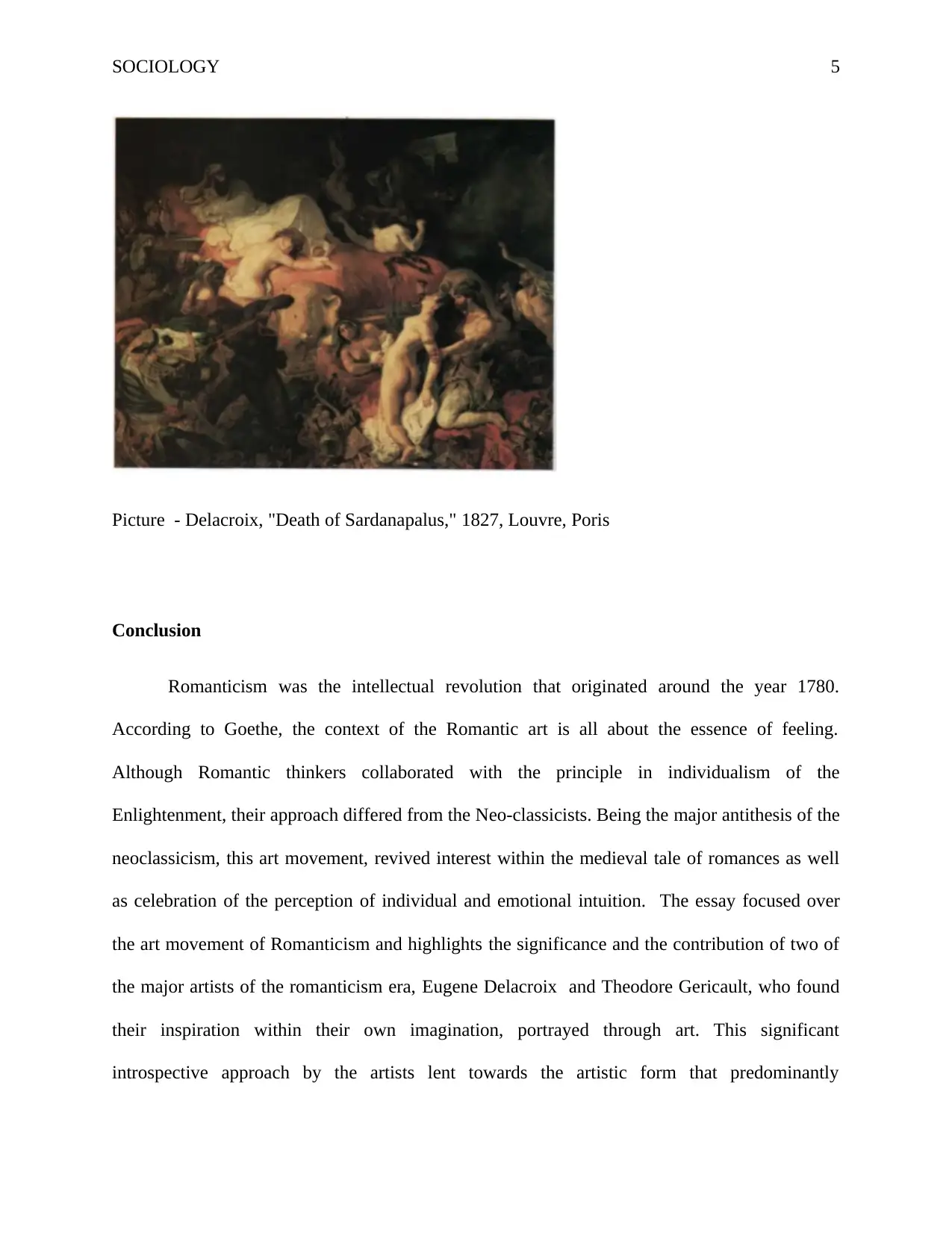
SOCIOLOGY 5
Picture - Delacroix, "Death of Sardanapalus," 1827, Louvre, Poris
Conclusion
Romanticism was the intellectual revolution that originated around the year 1780.
According to Goethe, the context of the Romantic art is all about the essence of feeling.
Although Romantic thinkers collaborated with the principle in individualism of the
Enlightenment, their approach differed from the Neo-classicists. Being the major antithesis of the
neoclassicism, this art movement, revived interest within the medieval tale of romances as well
as celebration of the perception of individual and emotional intuition. The essay focused over
the art movement of Romanticism and highlights the significance and the contribution of two of
the major artists of the romanticism era, Eugene Delacroix and Theodore Gericault, who found
their inspiration within their own imagination, portrayed through art. This significant
introspective approach by the artists lent towards the artistic form that predominantly
Picture - Delacroix, "Death of Sardanapalus," 1827, Louvre, Poris
Conclusion
Romanticism was the intellectual revolution that originated around the year 1780.
According to Goethe, the context of the Romantic art is all about the essence of feeling.
Although Romantic thinkers collaborated with the principle in individualism of the
Enlightenment, their approach differed from the Neo-classicists. Being the major antithesis of the
neoclassicism, this art movement, revived interest within the medieval tale of romances as well
as celebration of the perception of individual and emotional intuition. The essay focused over
the art movement of Romanticism and highlights the significance and the contribution of two of
the major artists of the romanticism era, Eugene Delacroix and Theodore Gericault, who found
their inspiration within their own imagination, portrayed through art. This significant
introspective approach by the artists lent towards the artistic form that predominantly

SOCIOLOGY 6
investigated the spiritual side of humanity, the nature’s sublimity and finally contributed to the
fruits towards personal freedom and peace.
investigated the spiritual side of humanity, the nature’s sublimity and finally contributed to the
fruits towards personal freedom and peace.
⊘ This is a preview!⊘
Do you want full access?
Subscribe today to unlock all pages.

Trusted by 1+ million students worldwide
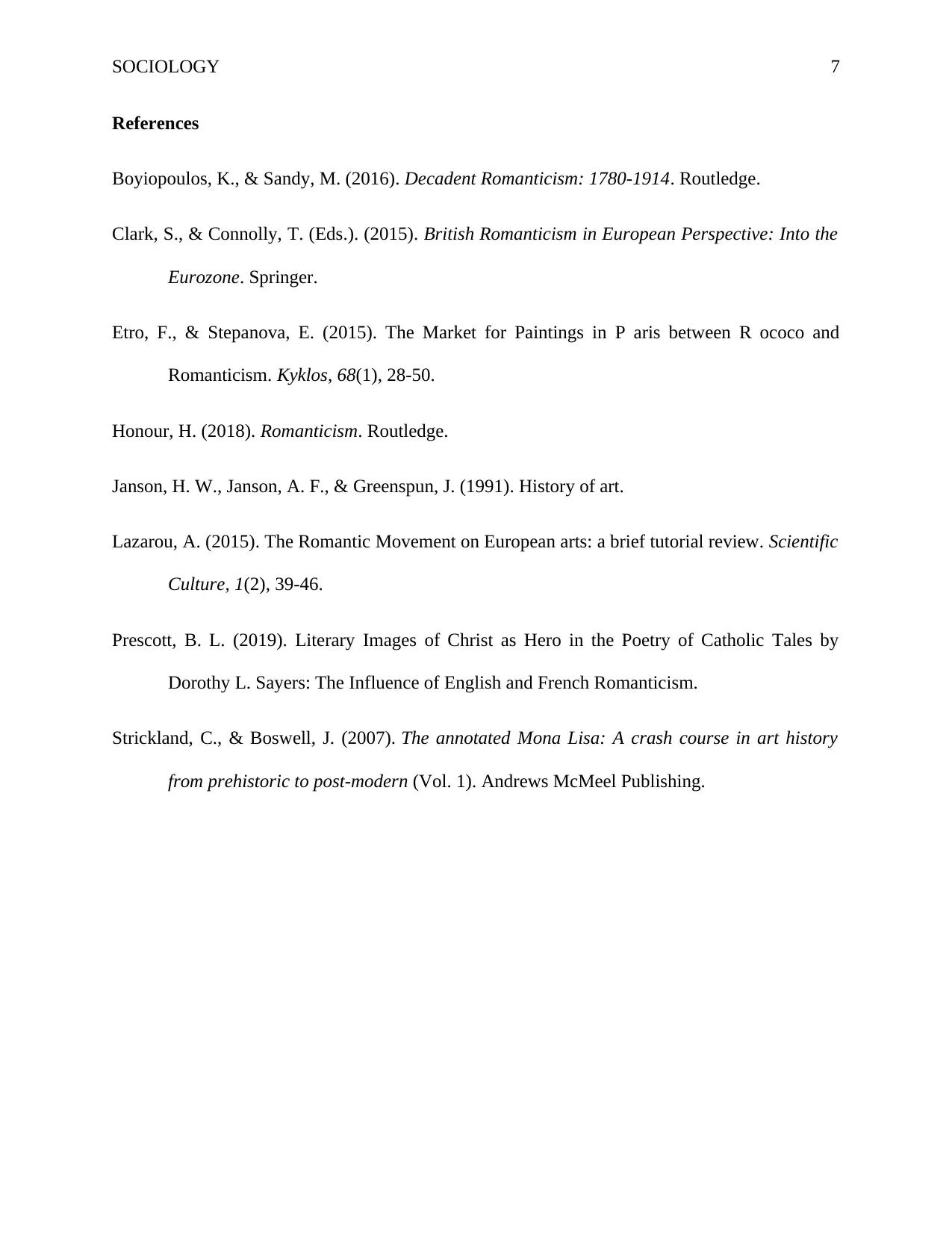
SOCIOLOGY 7
References
Boyiopoulos, K., & Sandy, M. (2016). Decadent Romanticism: 1780-1914. Routledge.
Clark, S., & Connolly, T. (Eds.). (2015). British Romanticism in European Perspective: Into the
Eurozone. Springer.
Etro, F., & Stepanova, E. (2015). The Market for Paintings in P aris between R ococo and
Romanticism. Kyklos, 68(1), 28-50.
Honour, H. (2018). Romanticism. Routledge.
Janson, H. W., Janson, A. F., & Greenspun, J. (1991). History of art.
Lazarou, A. (2015). The Romantic Movement on European arts: a brief tutorial review. Scientific
Culture, 1(2), 39-46.
Prescott, B. L. (2019). Literary Images of Christ as Hero in the Poetry of Catholic Tales by
Dorothy L. Sayers: The Influence of English and French Romanticism.
Strickland, C., & Boswell, J. (2007). The annotated Mona Lisa: A crash course in art history
from prehistoric to post-modern (Vol. 1). Andrews McMeel Publishing.
References
Boyiopoulos, K., & Sandy, M. (2016). Decadent Romanticism: 1780-1914. Routledge.
Clark, S., & Connolly, T. (Eds.). (2015). British Romanticism in European Perspective: Into the
Eurozone. Springer.
Etro, F., & Stepanova, E. (2015). The Market for Paintings in P aris between R ococo and
Romanticism. Kyklos, 68(1), 28-50.
Honour, H. (2018). Romanticism. Routledge.
Janson, H. W., Janson, A. F., & Greenspun, J. (1991). History of art.
Lazarou, A. (2015). The Romantic Movement on European arts: a brief tutorial review. Scientific
Culture, 1(2), 39-46.
Prescott, B. L. (2019). Literary Images of Christ as Hero in the Poetry of Catholic Tales by
Dorothy L. Sayers: The Influence of English and French Romanticism.
Strickland, C., & Boswell, J. (2007). The annotated Mona Lisa: A crash course in art history
from prehistoric to post-modern (Vol. 1). Andrews McMeel Publishing.
1 out of 7
Your All-in-One AI-Powered Toolkit for Academic Success.
+13062052269
info@desklib.com
Available 24*7 on WhatsApp / Email
![[object Object]](/_next/static/media/star-bottom.7253800d.svg)
Unlock your academic potential
Copyright © 2020–2025 A2Z Services. All Rights Reserved. Developed and managed by ZUCOL.

